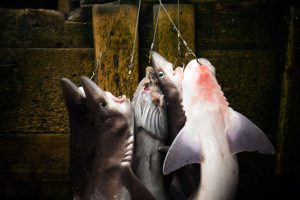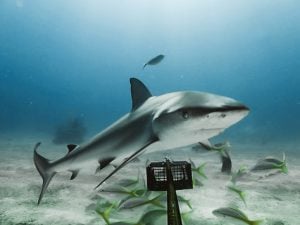
Wildlife
Jawsome: behind the scenes of Canada’s newest great white shark documentary
Korean-Canadian filmmaker Sonya Lee dives deep into the world of great white sharks for the latest documentary from CBC’s The Nature of Things
- 1781 words
- 8 minutes
Wildlife
Encountering the carcass of one of the ocean’s top predators and how studying its remains can help researchers save the living

A great white shark lying dead on the ocean floor isn’t quite how most scuba divers imagine their first encounter with one of the ocean’s most recognizable fish. Yet, that is exactly how it went for Sara Vanderkaden and two other local divers — unlike the half dozen other divers that have spotted great whites swim past them in the waters around Halifax over the last couple of years.

The divers had been taking part in an underwater cleanup led by the Nova Scotia Underwater Council in Terence Bay, about half an hour’s drive south of Halifax. That is when they were approached by a member of the community, telling them there might be a dead shark in the water nearby. While this kind of information piques any diver’s curiosity, it is also rare and highly unusual. Curiosity overruled the skepticism, so they set off in search of the shark the next day, unsure of what, if anything, they might find.
After a few minutes of searching on a muddy slope in 11 metres of water, the unmistakable white underbelly of the shark came into view, a literal stone’s throw from the shoreline. The carcass was still intact, but lobsters and fish were already nibbling away at it, exposing its cartilaginous skeleton.
“It was my first time seeing a great white shark in person,” recalls Vanderkaden, a marine conservationist and policy advisor. “It was a very surreal scene to see an apex predator to be so vulnerable and dead.”
Globally, great white sharks are listed as vulnerable by the International Union for Conservation of Nature. And like the majority of shark species, white shark numbers are declining. Faced with decreasing numbers in the North Atlantic, white sharks have been federally listed as endangered for more than a decade, with bycatch in commercial fisheries being a key threat. As a slow-growing species that sexually mature as late as 30 years of age, with long gestation periods (12 months), white sharks may only reproduce every couple of years. Like other slow-growing species, such as whales and sea turtles, this makes white sharks especially vulnerable to the threats they face and their eventual recovery.
According to researchers, however, great white sharks on the East Coast are on the rise, with factors such as warming waters and rebounding seal populations driving the species north. Yet, like with many other large animals that are in trouble, there’s still much about their lives that remains a mystery to us.

After locating the carcass, the divers immediately reported their findings to the Marine Animal Response Society (MARS), a world-leading Nova Scotia-based marine conservation charitable organization that responds to strandings throughout the Maritimes. Working to rescue stranded whales, seals, dolphins, sharks and sea turtles, MARS also collects samples from dead animals for diagnostics.
“We are trying to figure out the cause of death,” explains Tonya Wimmer, MARS’s Executive Director. “We use these opportunities to collect a wide range of research samples, either for ourselves in the hopes of research we want to be able to do if we can find funding.” Wimmer also explains that these opportunities can support collaborative research with scientists “because we have developed research partnerships with people who very much need and rely on being able to get samples.”

Teeth can determine a species’ age, tissues are used for genetic sequencing or detecting pollutants, and stomach content can shed light on an animal’s diet and brain biopsies, which can be informative of disease processes.“We try to help save the living, and then we study the dead to help save the living,” says Wimmer. Importantly, MARS holds a slew of permits to work with animals that are federally listed as endangered, rules that extend to dead animals, as well as any parts such as bones or teeth.
MARS normally responds to animals that wash up on shore from disease, entanglement in fishing gear or other reasons, procedures they’ve spent nearly a quarter of a century perfecting. However, for shark carcasses underwater, circumstances are different as tissues degrade more quickly, presenting a new and unique challenge. The MARS team would need to act fast to collect samples, with the hope that the cold waters of the North Atlantic would preserve the shark enough to give them a chance to collect useful samples.
Since 1999, only two or three great white shark deaths have been reported to MARS. Yet, the shark the divers found at the bottom of the bay outside of Halifax would mark the sixth event in a year, but the first white shark found underwater as opposed to found ashore.
MARS’ Coordinator of Response Operations, Matthew Mar, had responded to three of the strandings, all on land. Combined with his experience as a diver, he was well-placed to coordinate the underwater response and quickly assembled a team of divers to assist. There were some hesitations about sampling a shark underwater, “the danger of attracting other predators was not lost on me,” says Matthew.

Three days after the shark was first found, I joined Mar, Vanderkaden and two other divers to help document the response. As a conservation photographer and experienced diver who has previously photographed great whites in Nova Scotia, I was excited to be invited to dive with the response team.
It was mid-afternoon in early November 2023 when we arrived at the Terence Bay Government Wharf. The overcast skies and rain made it seem closer to dusk than day, and the water at depth was surely to be even darker. As we descended, a layer of fresh water from a nearby stream formed a halocline (a vertical zone in the ocean where the salinity of water rapidly changes with depth), reducing our ability to see clearly. However, a couple of meters deeper, visibility improved. We swam along the sandy slope, past abandoned lobster traps, boots and old tires, towards the shark. We found it in the same location, although the decomposition and effect of the lobsters were far more pronounced now.
Mar got to work quickly, using an underwater camera to conduct a photo survey of the shark and any distinguishing features or marks. It had reproductive claspers, indicating it was a male, and it was measured to be about 2.7 metres long – a juvenile shark, slightly longer than a diver head-to-fin. Inspecting its mouth, Mar extracted some teeth that would help confirm identification and aging. Using a dive knife, he then cut a portion of the pectoral fin for genetic sequencing. Next, the divers worked to turn the animal over onto its belly to assess its dorsal side. There were no obvious marks suggesting evidence of fishing nets or hooks or that the shark had collided with a vessel, eliminating obvious causes of death such as bycatch or a boat strike.

On land, time wouldn’t be limited like it is by a diver’s air supply. Sampling the shark underwater afforded no such luxury. It was more of a crude sampling effort than a necropsy. However, for Wimmer, any information is invaluable. “Whether it is something natural or human-caused, we need to get a handle on what threats and causes of deaths, what causes of illness and injury these animals are experiencing, and we really don’t have any of that information for white sharks,” she says.
Forty minutes into the dive, it was almost time to return to the wharf before the divers’ air ran low. One last gruesome but necessary task involved removing the head with a dive knife. Enclosed in the skull in the cold water, there was a chance the brain could be useful, as this piece of information might help provide clues to the shark’s demise.
Encephalitis (inflammation of the brain), possibly caused by bacteria, has been suspected as a possible cause in the Lamniform family of sharks, to which great whites belong. “What we have been finding in our great white shark necropsies is that some of the ones we’ve been seeing also have some brain inflammation,” says Wimmer. She explains that MARS and the scientists they work with have been trying to find answers, “they’re still tracking down what may be the cause of it if they think it actually has anything to do with cause of death,” she continues.
The divers played a small but vital role in what is a long, complex investigation involving many people and, for divers like Vanderkaden, that is not lost on her. “It was a gratifying moment to get to leverage my role as a recreational scuba diver and get to contribute positively towards marine conservation in this,” she says.
It will take many more months for the samples to be processed by scientists and perhaps much longer to find answers. Yet, with every piece of new information, MARS and the scientists that depend on their work add another piece to the complex puzzle, that is, the mysterious lives of great white sharks in Atlantic Canada and what might be killing them.
Are you passionate about Canadian geography?
You can support Canadian Geographic in 3 ways:

Wildlife
Korean-Canadian filmmaker Sonya Lee dives deep into the world of great white sharks for the latest documentary from CBC’s The Nature of Things

Wildlife
Can British Columbia’s spiny dogfish make the grade as the world’s first “sustainable” shark fishery?

Wildlife
Dr. Chris Harvey-Clark shares his experience coming face-to-face with one of the ocean’s top predators while scuba diving near Halifax, N.S.

Wildlife
Lead author Aaron MacNeil discusses what this means for coral ecosystems and what Canadians can do to help